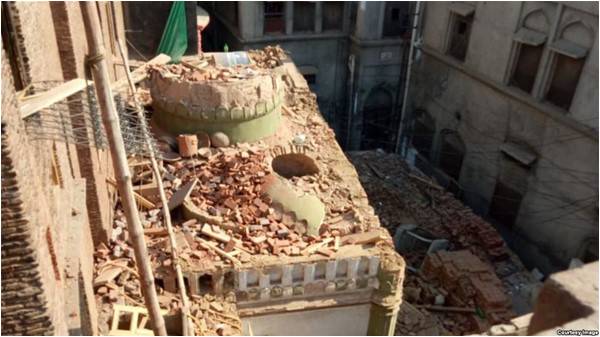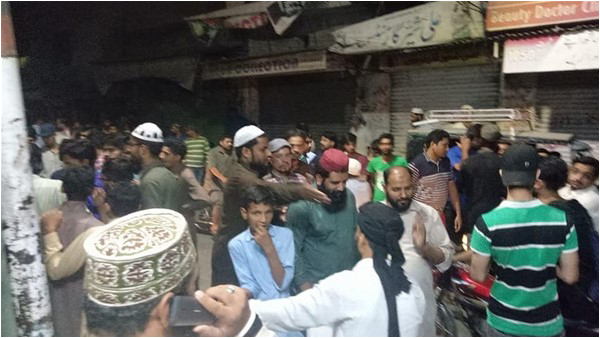
On May 24, a charged mob comprising hundreds of people destroyed two buildings associated with the Ahmadiyya community in Sialkot. The two sites targeted were Baitul Mubarik, a place of worship for the Ahmadis and the Jamaat founder’s residence.
Ownership of these sites is contested and this issue was used as a pretext for a first information report (FIR) registered on May 13 against the construction work that had been initiated on the sites by members of the Ahmadiyya community.
First, officials of the municipal authorities initiated the vandalising, citing their “illegality” since the new design had not been approved. Then, a mob instigated by local clerics charged on the sites, damaging both properties.
This latest attack is part of many challenges faced by the community, which has been a target of religiously-motivated violence and threats owing to their status as an excommunicated sect as per the second amendment to the Constitution of Pakistan in 1974. It was followed a decade later by the Ordinance XX in the Pakistan Penal Code, which barred Ahmadis from “posing as Muslims.”
In March, the Islamabad High Court ordered job applicants in the public service to declare their faith and also asked the state institutions to ensure that citizens are “easily identifiable” by faith.
The IHC gave this verdict following hearings on the initial amendment on the Khatm-e-Nabuwwat clause in the Election Reforms Act, 2017.
The amendments, which were later overturned, eliminated the separate voters’ list for Ahmadis ahead of the elections this year.
In paragraph six of his judgment, Justice Shaukat Aziz Siddiqui wrote that the parliament should, “Take measures which can completely terminate those who scar (the belief in Khatm-e-Nabuwwat).”
When the news of the initial Election Reforms Bill was reported in October 2017, a protest led by the Tehrik-e-Labbaik (TLY) was organised at Faizabad Interchange in Islamabad. The protestors disbanded after an agreement was reached with the government – which included the status of Ahmadis. Law minister Zahid Hamid also had to step down from his post as part of this agreement.

Following the deal with TLY, celebrations of Eid Milad un-Nabi in December saw incitement to violence against Ahmadis en mass. Stones were thrown at an Ahmadi leader’s house in Karachi’s Saddar area, an Ahmadi place of worship was defaced in Rawalpindi and an imam in Lahore’s Gulberg area asked worshippers to “attack Qadianis” (a derogatory term for Ahmadis).
This led to a widespread insecurity among the community across the country, with many Ahmadis citizens moving from their homes and neighborhoods as they feared for their lives and safety.
A similar sense of insecurity has engulfed the Ahmadi residents of Sialkot, who feel that the mob which had targeted their historical sites could target them again.
“They targeted us on Eid Milad-un-Nabi, and now they are targeting us in Ramzan,” says Harris, a resident of the area. “Unfortunately, many members of the community have fled following the attack on the place of worship, and they will not return any time soon.”
Local authorities had sealed the residence a week before the mob attack. But the Ahmadiyya leaders maintain that even when the municipal officials were razing the site, they did so without any official order or notice.
“We acquired the property in 2014. The dispute over the residence was just used as a pretext to vandalize the building and the [place of worship],” says Jamaat-e-Ahmadiyya press in-charge Aamir Mehmood.
“They spread rumours that a ‘Qadiani museum’ was being created, which we won’t allow. Maulvi Khadim Hussain from Doongabad issued a warning to the authorities to take down the building or face consequences.
Ahmadiyya community spokesperson Saleemuddin says that the place of worship was not disputed property and it was only the renovation work on the residence that the local authorities sent a notice against.
“But since the [place of worship] is nearby, the mob targeted it as well and destroyed the minarets. We are pushing an FIR, which we have been told has been registered, although we are yet to receive a copy,” he says. “But we are pursuing the case, and we’ll take it to court.”
Ownership of these sites is contested and this issue was used as a pretext for a first information report (FIR) registered on May 13 against the construction work that had been initiated on the sites by members of the Ahmadiyya community.
First, officials of the municipal authorities initiated the vandalising, citing their “illegality” since the new design had not been approved. Then, a mob instigated by local clerics charged on the sites, damaging both properties.
This latest attack is part of many challenges faced by the community, which has been a target of religiously-motivated violence and threats owing to their status as an excommunicated sect as per the second amendment to the Constitution of Pakistan in 1974. It was followed a decade later by the Ordinance XX in the Pakistan Penal Code, which barred Ahmadis from “posing as Muslims.”
In March, the Islamabad High Court ordered job applicants in the public service to declare their faith
In March, the Islamabad High Court ordered job applicants in the public service to declare their faith and also asked the state institutions to ensure that citizens are “easily identifiable” by faith.
The IHC gave this verdict following hearings on the initial amendment on the Khatm-e-Nabuwwat clause in the Election Reforms Act, 2017.
The amendments, which were later overturned, eliminated the separate voters’ list for Ahmadis ahead of the elections this year.
In paragraph six of his judgment, Justice Shaukat Aziz Siddiqui wrote that the parliament should, “Take measures which can completely terminate those who scar (the belief in Khatm-e-Nabuwwat).”
When the news of the initial Election Reforms Bill was reported in October 2017, a protest led by the Tehrik-e-Labbaik (TLY) was organised at Faizabad Interchange in Islamabad. The protestors disbanded after an agreement was reached with the government – which included the status of Ahmadis. Law minister Zahid Hamid also had to step down from his post as part of this agreement.

Following the deal with TLY, celebrations of Eid Milad un-Nabi in December saw incitement to violence against Ahmadis en mass. Stones were thrown at an Ahmadi leader’s house in Karachi’s Saddar area, an Ahmadi place of worship was defaced in Rawalpindi and an imam in Lahore’s Gulberg area asked worshippers to “attack Qadianis” (a derogatory term for Ahmadis).
This led to a widespread insecurity among the community across the country, with many Ahmadis citizens moving from their homes and neighborhoods as they feared for their lives and safety.
A similar sense of insecurity has engulfed the Ahmadi residents of Sialkot, who feel that the mob which had targeted their historical sites could target them again.
“They targeted us on Eid Milad-un-Nabi, and now they are targeting us in Ramzan,” says Harris, a resident of the area. “Unfortunately, many members of the community have fled following the attack on the place of worship, and they will not return any time soon.”
Local authorities had sealed the residence a week before the mob attack. But the Ahmadiyya leaders maintain that even when the municipal officials were razing the site, they did so without any official order or notice.
“We acquired the property in 2014. The dispute over the residence was just used as a pretext to vandalize the building and the [place of worship],” says Jamaat-e-Ahmadiyya press in-charge Aamir Mehmood.
“They spread rumours that a ‘Qadiani museum’ was being created, which we won’t allow. Maulvi Khadim Hussain from Doongabad issued a warning to the authorities to take down the building or face consequences.
Ahmadiyya community spokesperson Saleemuddin says that the place of worship was not disputed property and it was only the renovation work on the residence that the local authorities sent a notice against.
“But since the [place of worship] is nearby, the mob targeted it as well and destroyed the minarets. We are pushing an FIR, which we have been told has been registered, although we are yet to receive a copy,” he says. “But we are pursuing the case, and we’ll take it to court.”

